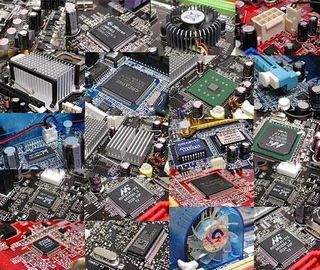Six 975X Enthusiast Motherboards for Today and Tomorrow
Intel 975X Motherboard Battle, Spring 2006

From a platform point of view, the last few months have been rather slow. There have been no significant chipset innovations, and the processor speeds of both CPU players have not increased. This summer, however, things will change dramatically. AMD is on the verge of a significant platform transition that is starting now. For its part, Intel will replace its good old Pentium family with the all-new Core 2 processor family in the summer, as it works to be reinstated as the undisputed #1 processor company.
Intel has emerged victorious in preliminary benchmark runs that compared the 2.66 GHz Core 2 Duo E6700 against an overclocked AMD Athlon 64 FX-60. Those test systems were assembled and installed by Intel, but our own benchmark results give little reason to doubt the company's performance claims. In fact, we are pretty sure that Intel will at least make up for the current gap in performance and energy efficiency - it will likely overtake AMD sometime this summer.
But the Texans are not asleep, of course. The platform change will transition both the mainstream Socket 939 and the budget Socket 754 to the new 940-pin AM2 socket - "one platform to rule them all". Performance levels will initially not change much; Socket 939 and AM2 processors at equal clock speeds perform more or less alike. Although looking much faster on paper, the new DDR2-800 memory interface provides only small performance benefits when compared to its DDR400 Socket 939 counterparts. However, DDR2 RAM is indeed quite beneficial in terms of lowering memory costs per megabyte: you can expect 2 and 4 GB RAM soon at the cost you pay for 1 or 2 GB today. If you wonder why you may need 2 GB of RAM or more, think long term - think Windows Vista.
Although AMD's 90 nm SOI manufacturing cannot keep up with Intel's winning combination of a 65 nm process and the efficiency-tuned Core 2 micro architecture, AMD is working on its own 65 nm process. The firm will stick to its elaborate silicon-on-insulator manufacturing, so we expect it to be back in the race as soon as the yields allow output of high-speed parts in quantity.
There are many motherboards available that are capable of working with both today's Pentium 4 and Pentium D processors, as well as with the majority of the upcoming Core 2 models. However, please make sure you verify Core 2 support before purchasing a particular motherboard, as it may not coexist well with old motherboard revisions.
We looked around and selected several current 975X motherboards for review. There are several alternatives with Nvidia chipsets around as well, but given that nForce4 will be replaced by the nForce 500 family soon, we decided to leave them out for now.
Join our discussion on this topic
Stay on the Cutting Edge
Join the experts who read Tom's Hardware for the inside track on enthusiast PC tech news — and have for over 25 years. We'll send breaking news and in-depth reviews of CPUs, GPUs, AI, maker hardware and more straight to your inbox.
Current page: Intel 975X Motherboard Battle, Spring 2006
Next Page The 975X ChipsetMost Popular


